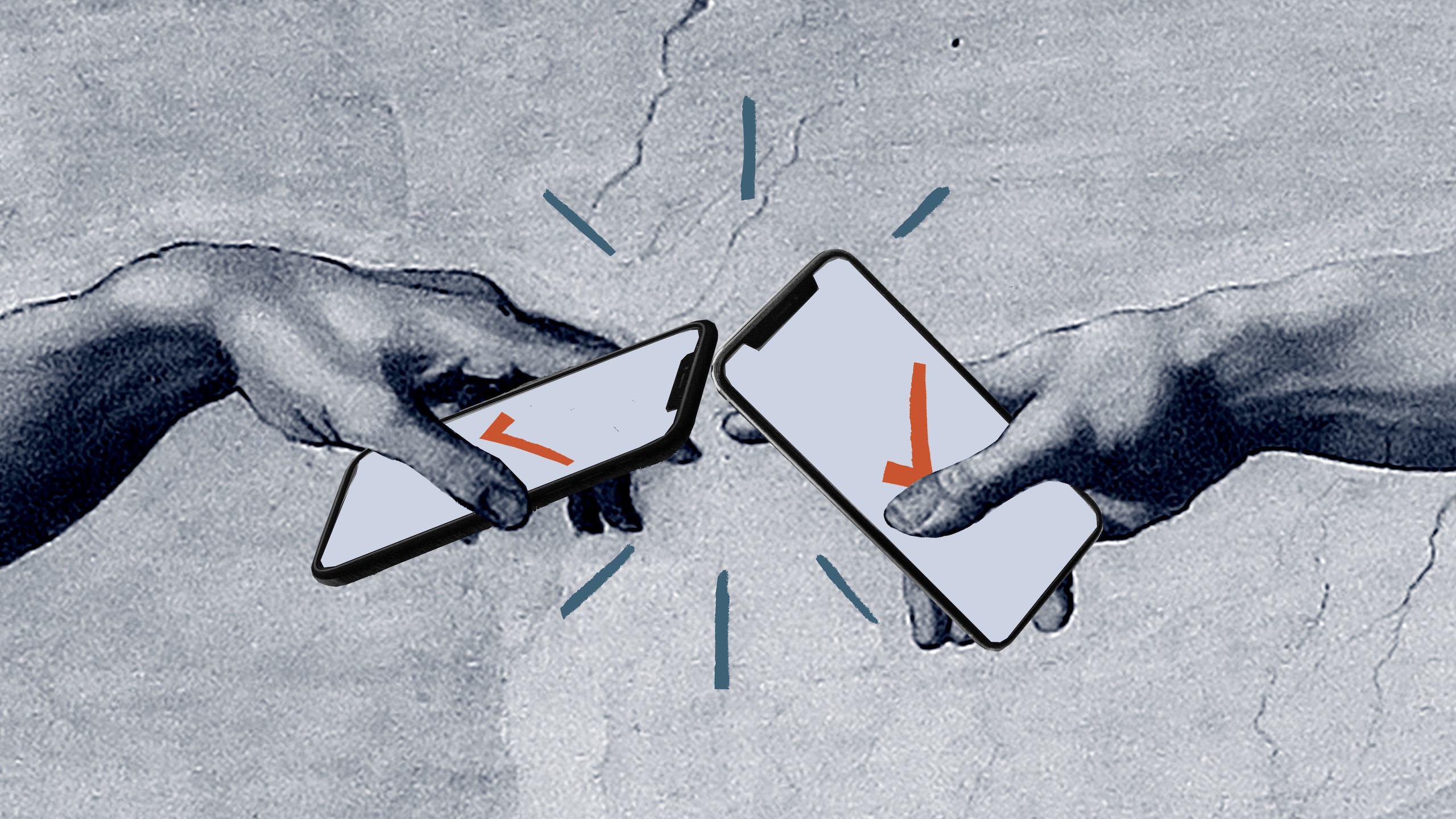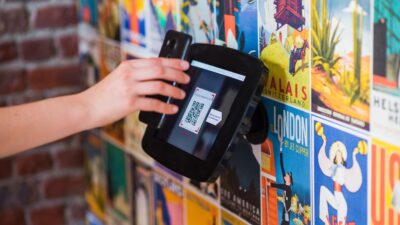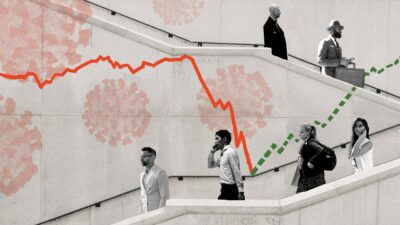Sandra Peter and Kai Riemer

Contact tracing revisited on Corona Business Insights
We look at lessons learned from the use of digital contact tracing apps, launched with great promise early in the pandemic, but now largely regarded as ineffective by many countries.
As COVID-19 sets out to change the world forever, join Sandra Peter and Kai Riemer as they think about what’s to come in the future of business.
Shownotes
Our resource page on contact tracing efforts
Our previous discussion of contact tracing on Corona Business Insights
Australian government urged to look at COVIDSafe app alternatives
Research on the epidemiological impact of the NHS COVID-19 app
MIT Technology Review investigation on whether digital contact tracing actually worked in the US
The difference in transmission of the Delta variant of COVID-19
COVIDSafe will have to be updated to be effective against the Delta variant
Wastewater detection of COVID-19 fragments
Colorado Mesa University’s contact tracing program
Concerns about the security of the COVIDSafe app
No complaints or breaches against COVIDSafe
User data accessed from QLD check-in app
Apple and Google pledge to shut down coronavirus tracker when pandemic ends
This episode is part of a podcast series covering what COVID-19 will mean for the business world, where we look at the impact on the economy, businesses, industries, workers and society. This is part of our ongoing coverage of the impact of COVID-19 on the future of business.
Follow the show on Apple Podcasts, Spotify, Overcast, Google Podcasts, Pocket Casts or wherever you get your podcasts. You can follow Sydney Business Insights on Flipboard, LinkedIn, Twitter and WeChat to keep updated with our latest insights.
Send us your news ideas to sbi@sydney.edu.au.
Dr Sandra Peter is the Director of Sydney Executive Plus and Associate Professor at the University of Sydney Business School. Her research and practice focuses on engaging with the future in productive ways, and the impact of emerging technologies on business and society.
Kai Riemer is Professor of Information Technology and Organisation, and Director of Sydney Executive Plus at the University of Sydney Business School. Kai's research interest is in Disruptive Technologies, Enterprise Social Media, Virtual Work, Collaborative Technologies and the Philosophy of Technology.
Share
We believe in open and honest access to knowledge. We use a Creative Commons Attribution NoDerivatives licence for our articles and podcasts, so you can republish them for free, online or in print.
Transcript
Intro From The University of Sydney Business School, this is Sydney Business Insights.
Sandra And this is Corona Business Insights. I'm Sandra Peter.
Kai And I'm Kai Riemer.
Sandra And we're back unpacking the impact of COVID-19 on business, the economy, industry, government, workers, and society and looking at the effects of the pandemic.
Kai And we haven't done one of these in a long while, Australia has largely been COVID free, but now we're both back in lockdown.
Sandra As are 11 million other Australians as seven cities across Australia are currently in lockdown due to the spread of the Delta variant.
Kai And we're back taking a look at where the COVID-19 pandemic has left us on a range of topics.
Sandra And this podcast is part of a larger initiative by The University of Sydney Business School.
Kai And you can still find our COVID business impact dashboard online at sbi.sydney.edu.au/coronavirus.
Sandra It's become clear to all of us that COVID-19 won't disappear anytime soon, and there's likely to be a new pandemic. So we are revisiting one of our very first topics that we did on Corona Business Insights when the pandemic first hit Australia at the start of 2020. And that was digital contact tracing.
Kai So digital contact tracing apps were launched by many countries with great promise to curb the spread of the pandemic. It has become clear, though, in the meantime, that in many countries, the effect was minimal. And so they're pretty widely regarded as failures now, so we thought we'll have a look what actually happened.
Sandra And also what lessons we can learn for the future.
Kai So just to remind everyone, when we say digital contact tracing, we typically mean smartphone apps that trace the proximity of people carrying those phones. So people might spend time with each other in close proximity, typically, like 15 minutes at one and a half metres or closer. And the phones would then automatically record that proximity and should one of the people test positive, they could then elect to have the system notify anyone who came in close contact with them so that they can get tested them self-isolate.
Sandra And since the beginning of 2020, such apps have been in place in over 50 countries around the world. And we've been tracking these apps last year on our website. But the picture that has emerged since then has been quite mixed. Few countries in Europe, such as the UK or Switzerland and Germany have reported some positive results with digital contact tracing. But in places like Australia, public sentiment has been quite negative. And the COVIDSafe app that we all have installed has been largely called a tremendous waste of taxpayer money.
Kai So we want to have a look at what can we actually learn from this? And is this a complete waste? Or is there not a role for digital contact tracing as we go forward?
Sandra So the two of us sat down and tried to figure out what are the lessons from a year and a half of digital contact tracing efforts based on our research, our colleagues research, and various efforts to implement this across the world.
Kai So we identified eight lessons learned from almost one and a half years of digital contact tracing that might be useful as we move forward and prepare for future pandemics.
Sandra First lesson: there seems to be no real benefit to digital contact tracing when there is no clear immediate health risk.
Kai So in places where there's really not much going on with COVID, very low levels of infection like in Australia, for example, these digital contact tracing apps really won't do much. There's just not enough infections for these apps to pick anything up.
Sandra And in these case is things like manual contact tracing, combined with check-in apps for accessing venues provide much better outcomes.
Kai And that's really been the case in Australia where QR code check-in apps for venues have been the backbone of how we record people's whereabouts and how we start tracking and tracing when there are infections and contacts.
Sandra And where we've largely had localised outbreaks, but mostly we have been COVID-free for extended periods of time.
Kai So the second lesson is that digital contact tracing can actually be really useful in places where there's widespread and prolonged infections and high growth rates. So where the virus is spreading out of control in large populations.
Sandra We actually foreshadowed this in research that we published together with our colleagues, Raffaele Ciriello and Daniel Schlagwein.
Kai And that was published in the European Journal of Information Systems last year. And we looked in particular at the adoption of digital contact tracing as the necessary basis for the success of these apps.
Sandra And the UK provides a really good example of this recent study in Nature has shown that National Health Service app in the UK sent out about 1.7 million exposure notifications in the last two and a half months of 2020.
Kai So this was right after the app was launched, the researchers found a very positive effect of the app, they estimate that the app averted between 300-600,000 new infections in this period alone. And based on modelling, they concluded that every 1% of app uptake, of adoption in the population, can actually reduce the number of cases between .8 and 2.3%. So there's a real positive correlation between adoption and use of these apps. And curbing the spread of the virus as it runs rampant in the community.
Sandra Lesson number three is around adoption. And that adoption really is critical and need significant resourcing. And without widespread support from all stakeholders in the community adoption rate, or usage rates, have really remained below the necessary threshold of at least 15%, at which digital contact tracing has any measurable benefits.
Kai So that's been the case in many of the states across the US where you have individual apps in each of the states and also in many other countries. In the UK however, for example, when this study was carried out, the total adoption rate was 28%. So that's at a level where you can actually expect a positive effect. And that was actually shown in the research, of course.
Sandra And our research here at the business school also shows that adoption will depend on the immediate health risk, on the prior experience that country has with pandemics, on things like societal values, national culture, the role that government plays, and especially trusting government and trusting technology in the respective society.
Kai So countries where there is an actual outbreak raging like the UK, are obviously in a better position to have the app adopted because people see the need vis-à-vis Australia where we never had the kind of immediate needs for adoption of the COVIDSafe app. And then of course, it's important that government is behind this and puts significant resourcing into promoting the collective benefits of app uptake and adoption.
Sandra Lesson number four is that digital contact tracing needs continuous development. We've seen with COVID-19 that the virus mutates that new variants, many of which are more easily transmissible, really highlight the need to adjust the infection exposure window.
Kai So COVIDSafe in Australia still operates on the 15-minute exposure at one and a half metre distance. But recent contact tracing efforts have shown that the Delta variant is much more infectious than that.
Sandra Apparently, infection can now occur after just five to 10 seconds during what might be a fleeting encounter with a passer-by. So contact tracing apps like COVIDSafe would have to change the way they filter the information that is collected from people.
Kai And so for some apps such as COVIDSafe, that might mean that the information needs to be filtered differently because it already collects way more information than is being used. But other apps might have to actually undergo a major redesign to accommodate virus mutations at different infection rates.
Sandra Lesson number five has to do with integrated tech solutions. During the pandemic, a number of other technologies other than digital contact tracing have been integral to fighting the virus. And as the virus changes, and as we're facing potential new pandemics, it's become quite clear that contact tracing along with check-in apps, with symptom reporting, with local wastewater testing, vaccination passport technologies all play a role in controlling the spread of the virus.
Kai And for Australia, for example, we think it's a missed opportunity that the state based QR code check-in apps that we use when we enter a venue here have never really been integrated with COVIDSafe. So if COVIDSafe was the app that does the check in not only would we have a national solution, but we would also combine the digital contact tracing with the QR code check-in.
Sandra In the UK, for instance, the COVID ZOE Symptom Tracker app, which allows users to log their symptoms played a critical role in understanding how the virus affects different groups of people and how different variants might present with very different symptoms.
Kai In Australia we do local wastewater testing at the suburb level. And information from this can be an early warning sign that there might be an outbreak lurking and might be integrated into contact tracing apps and displayed to users so that they can be extra cautious as they move about the community.
Sandra And so integrated approaches can help better manage the pandemic. And a system developed by Colorado Mesa University actually showcases such an integrated approach where they bring together self-reported student symptoms, wastewater testing, contact tracing, and sequencing data from student tests to develop geographic heat maps that can identify and prevent outbreaks as they emerge.
Kai And we'll put the link to this case into the shownotes. Now lesson number six is that convenience really trumps privacy.
Sandra While privacy was a main concern during the early adoption of digital contact tracing, later we've seen the use of more and more invasive tracking solutions that really showcase the fact that users do prioritise convenience over their privacy once it comes to day-to-day activities and day-to-day use.
Kai So when we think back at the discussion around all the privacy concerns that surrounded the COVIDSafe app and digital contact tracing, and that people were afraid that their location might be logged, that this app might know where people have been, it's really quite surprising that today we'll readily give up our location information every time we enter a venue with a QR code.
Sandra So indeed, convenience does seem to trump privacy. While there have been no reports of breaches, no complaints made, no investigations under way regarding the COVIDSafe tracing app, the widely used QR code check-in apps have revealed that their data has been accessed by police in a number of states for various law enforcement activities.
Kai It's also quite interesting that it was so important that COVIDSafe adoption was going to be voluntary., when it's really mandated that we have to use the QR code to get into a venue. So there's a certain coercion there. And it has been shown that those privacy concerns have actually come through with the QR code apps. And people don't seem to care by and large, because it has enabled us to go back to a form of normal living, at least before we had the recent outbreak.
Sandra Lesson number seven: reliance on big tech is a double-edged sword.
Kai This is not so much for Australia, because here we have our own homegrown solution. But in many parts of the world, in Europe and across the US, digital contact tracing apps are based on the exposure notification framework that both Apple and Google in collaboration set up, and that basically functions at the operating system level.
Sandra And that obviously dramatically increases adoption and the use of these things. On iPhones, you never have to instal an app, the exposure and notification system just goes about its business in the background, unlike with other solutions, where you actually have to go download something, install something on your phone.
Kai And also open it up regularly so that it can function properly in the foreground because it doesn't integrate as deeply as Apple and Google can do in their own operating systems.
Sandra However, the system has been developed by private tech companies. And Google and Apple said last year that they do plan to shut down the exposure notification program after the pandemic ends, however they decide to define that, potentially cutting off resources to countries which might still be struggling with outbreaks or with new variants of the virus, or indeed with new pandemics.
Kai Yes, when the US comes out of the pandemic, and maybe the urgency of tracking fades into the background, it remains to be seen whether the framework is still in operation and will still be developed, and indeed adjusted to new variants that might be rampant in countries that are outside of places like Europe or the US.
Sandra And lesson number eight: interoperability between jurisdictions.
Kai So the COVID-19 pandemic has really highlighted the failure to coordinate responses across geographic areas, be it across states in the United States, sometimes there's been conflict here in Australia between states but also largely on a global level with very different regional outcomes when it comes to fighting the pandemic.
Sandra And whether in the midst of the pandemic, or as we're coming out of the pandemic and starting to travel again, these tracing solutions really need interoperability across states and countries to avoid prolonged travel bans and the isolation that many countries find themselves in.
Kai Like, for example, in Australia, where it's virtually impossible for citizens to leave the country at the moment or for people to enter the country. But as we prepare for future pandemics, and as we learn from this pandemic, it will pay off to actually build solutions that from the start of a new outbreak of a different virus might be able to be activated at an international level, so that we can avoid those shutdowns and therefore also the disruption of travel, tourism, business, and supply chains.
Sandra And that's all we have time for today.
Kai Thanks for listening.
Sandra Thanks for listening
Outro From The University of Sydney Business School this was Corona Business Insights, the podcast that explores the future of business in the wake of the global pandemic.
Sandra Connect with us on LinkedIn, Twitter, WeChat, and Flipboard, and subscribe, like or leave us a rating wherever you get your podcasts.
Close transcript







